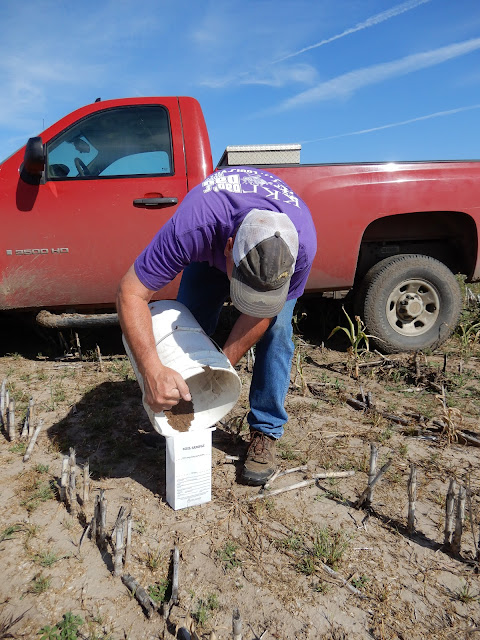I went along for the ride as Randy did soil samples in freshly-harvested wheat fields. Yes, farmers notoriously like to dig in the dirt, but this expedition had a deeper purpose. (Why just leave it at one corny pun per blog post?)
Randy was gathering soil samples to have analyzed at the co-op. Actually, they send the samples off to a lab, which analyzes it for nitrogen and other nutrients. Because of the all the rain we've gotten this year, Randy knew there would be a greater deficiency of nitrogen, which leaches out after rain. He wanted the information so he can make the best management decisions about how much nitrogen and other soil nutrients to add before planting wheat this coming fall.


He labeled each sample bag with the name of the field and what he wanted evaluated.

He collected soil samples in four different fields. That way, he can apply the fertilizer and other nutrients specifically needed at the different locations.
Once collected, we took the sample bags to the Zenith branch of the co-op, and they sent them off to Servi-Tech.
As predicted, the soil samples revealed the need for additional nitrogen. Some of the fields also showed an increased need for phosphorus. Randy will use the test details to work with the co-op to determine the percentages of nutrients in the fertilizer.
And that is why I ask the probing questions ... so you, too, can know why we do what we do. Unlike what some modern farming detractors would have you believe, we're not just "pouring chemicals" on crops. We are doing our best to maximize the soil and our own resources. That sounds like a good business plan to me.






I love the new header. I also love how you, Randy and the farm conect me to my farming roots so regularly.
ReplyDeleteI hope many, many more people than comment, read your blog. It comes over as a very normal couple caringly doing what they love on their land.
Honestly, it's sometimes discouraging. The "experts" say farmers should connect with consumers and "tell our own story." However, I find that people aren't that interested in reading about it. I guess I continue to do it because it's an avenue for my amateur photography and a way to keep the farm's history. Thanks for being a loyal reader! The header was taken a year ago in August on the way to one of our summer pastures. Thanks, Helen!
DeleteI love taking soil samples! We only have pastures and grass hay fields, but a good sampling/evaluation tells you so much. Its fun to try and figure out what all the data means once you receive the test results. I guess I'm just a geek :).
ReplyDeleteAre those Maximilian Sunflowers in the top photo? So pretty.
They are! I've been noticing a few blooming. I took that photo last August. I see the regular sunflowers all the time, but the Maximillan sunflowers aren't in bloom all summer long.
Delete